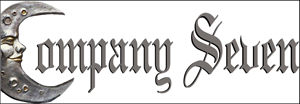
Company Seven | Ultraviolet Spectrum Primer
Understanding the ultraviolet spectrum, written in support of the specialized ultraviolet capable products distributed by Company Seven
Introduction:
Company Seven offers optical lenses and microscopes that are designed to work not only in the visible spectrum but into portions of the spectrum that are invisible to the eye and to conventional camera and lens systems. In this article we provide a working introduction to working in the ultraviolet spectrum.
Since most conventional lenses and even their antireflection coatings may interfere with the transmission of ultraviolet light, the optical systems and filters that we offer for work into the UV will incorporate refractive components made of special optical materials. These lens materials may include UV grade Calcium Fluoride (CaF2) and/or Fused Silica (Quartz). Among these is the highly acclaimed Nikon UV-105 F4.5 lens, a limited production lens originally developed for specialized applications in the ultraviolet (UV) and infrared (IR) portions of the spectrum. This Nikon UV lens is complemented by our other systems including Long Distance Microscopes that can resolve details down to the sub-micron level deep into the ultraviolet, and even to below 200nm. Lenses based on all reflecting arrangements (Cassegrain, Newtonian, etc.) can be made to transmit ultraviolet however, these designs are not as practical for most applications as will be a lens (refracting) based system.
Above left: an example of the catadioptric long distance microscopes we offer is the Questar QM 100 (29,309 bytes).
Above right: Nikon UV-105 F4.5 refractive lens (14,642 bytes).
UV light is electromagnetic radiation with a wavelength shorter than that of visible light (400 to 700nm), yet longer than x-rays. UV is considered to span the range from 10 nm to 400 nm. Our Nikon 105 UV lens for example can operate at wavelengths between 220 to 900 nm, while our UV capable Long Distance Microscopes span from 180nm to 2 microns (the chart shows only up to 900nm). Note for reference we also show where the Fraunhofer lines (A to K) typically of interest to telescope and lens designers correlate on the spectrum below:
As amazing as it can be to explore the ultraviolet spectrum, this is not child’s play therefore:
When working near shorter wavelengths sources of UV-B or UV-C fully cover the eyes and skin too.
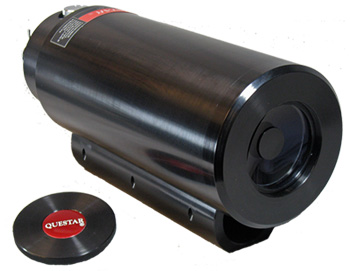
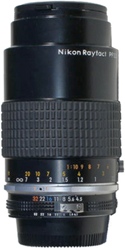
These systems can be ordered with optical components that permit operation down to 180nm in the ultraviolet.
This lens transmits to below 220nm in the ultraviolet, through the visible spectrum, up and to beyond 900nm in the infrared.
Ultraviolet (UV) Primer:

Above: spectrum spanning from the vacuum ultraviolet (180nm), through the visible, and into the infrared (above 900nm).
This also illustrates several of the better known Fraunhofer lines (C to K).
Above: images taken in ultraviolet (350nm), visible and infrared for comparison (100,722 and 108,277 bytes).
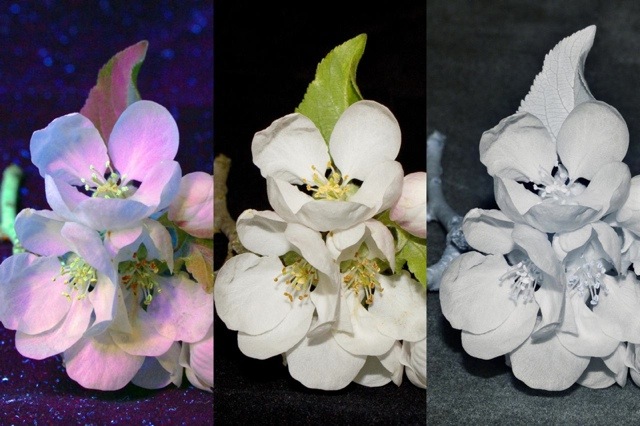
For fun: flower blossoms in UV, visible, IR light

Catching bad guys: scratches in UV, visible, IR light
Images courtesy of R. Horsnell. Click on images to see enlarged views (260,042 and 136,271 bytes).
 WARNING Infrared (IR) and ultraviolet (UV) wavelengths are invisible to the human eye, yet these electromagnetic waves do bear energy and other information. Any structure that absorbs light that incorporates UV and or IR can be damaged by this energy; note how prolonged exposure to sunlight can tan the skin, while prolonged exposure fades or even breaks down materials. The photons of shorter wavelengths carry greater energy than those of longer wavelengths therefore these have the greater potential for causing biological damage. The shorter wavelengths can penetrate the eye or skin cells and can produce heating and energy related biological changes that will modify or destroy cellular DNA; this is among the reasons why UV-C light sources are incorporated into many germicidal (sterilizing) apparatus.
WARNING Infrared (IR) and ultraviolet (UV) wavelengths are invisible to the human eye, yet these electromagnetic waves do bear energy and other information. Any structure that absorbs light that incorporates UV and or IR can be damaged by this energy; note how prolonged exposure to sunlight can tan the skin, while prolonged exposure fades or even breaks down materials. The photons of shorter wavelengths carry greater energy than those of longer wavelengths therefore these have the greater potential for causing biological damage. The shorter wavelengths can penetrate the eye or skin cells and can produce heating and energy related biological changes that will modify or destroy cellular DNA; this is among the reasons why UV-C light sources are incorporated into many germicidal (sterilizing) apparatus.
 It is vital that suitable eye safety protection be used when working with any UV light source.
It is vital that suitable eye safety protection be used when working with any UV light source.
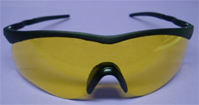
- UV–A is associated with aging of the skin by unprotected exposure to sunlight. When the skin cells’ DNA is damaged by UV radiation then Apoptosis (Type I cell death) is triggered and the skin is replaced; malignant melanoma may occur as a result of indirect DNA damage when the damage is not properly repaired. Proper repair occurs in the majority of DNA damage therefore not every exposure to UV results in cancer. While Earth’s atmosphere provides some protection the exposure to both UV–A and UV–B increases by ten percent (10%) for every 1,000 feet rise in elevation. Residents of those areas of Earth where ozone has been depleted suffer from greater exposure hence a higher percentage of skin and eye damage including cancers.
The Black Light and the Wood’s Lamp are among the more common manmade sources of UV–A, these are used for hobby and entertainment effects with most sources peaking anywhere between 370 to 450 nm. All reptile lamps emit UV–A while some lamps may emit a moderate amount of UV–B too; these are used in terrariums to maintain pet health. While the human eye can not see most of the radiation emitted by a Black Light certain colors and pigments absorb the invisible light then discharge it appearing as a glowing effect. The eerie appearance of posters when observed under UV are one example of this effect. Detergents may contain as much nine percent (9%) phosphorus content, the phosphors absorb UV radiation then expels them as light so that white fabrics shine brilliantly under a Black Light.
- Medium wave UV-B is a higher energy electromagnetic radiation than UV-A hence it can penetrate deeper into the human skin. This increases the likelihood of skin cell DNA absorbing this energy and being modified or destroyed, because of this the letter "B" in UV-B has been associated with "burn" as in sunburn. The ozone layer of Earth’s atmosphere attenuates UV-B however, the amount of UV-B that penetrates the atmosphere to ground level at the equator has historically been about 1,000 times greater than that at the poles. But every one percent (1%) decrease of the ozone layer in the atmosphere results in a two percent (2%) increase in UV-B exposure and a four to six percent (4-6%) increase in carcinoma. Additionally, a correlation between incidence of squamous cell carcinoma of the eyes conjunctiva and exposure to UV–B ultraviolet light has been noted; this can be a local disease process or metastasize to become fatal.
There are Black Light sources employing MgSrAl10O17, Ce phosphors that emit as low as 310 nm peak. Medium wave UV-B sources cause certain bodily fluids to luminesce, so crime scene investigators and forensic laboratories employ these to detect blood, saliva, semen, and other fluids. Medium wave Black Lights are also used to detect anti-counterfeit markers in currency and have many other security applications including screening for counterfeit currency.
- Most of the natural short wave UV–C radiation emitted by the Sun is absorbed in the Earth’s atmosphere so most human exposure to UV–C will originate in artificial sources including Low-Pressure Mercury Arc Lamps. Short wave ultraviolet radiation can also cause sunburn. Short wave ultraviolet is almost completely stopped by most forms of glass or plastic, so quartz (fused silica) or special glasses must be used in the manufacture of short wave light tubes so that the short wave UV–C radiation can pass out of the tube. Short wave ultraviolet is the most popular illumination source for observing mineral fluorescence and phosphorescence producing this in perhaps ninety percent (90%) of fluorescing minerals.
A short wave UV–C sterilizing tube lamps emits radiation that is destructive enough to purify water of living contaminants and to sterilize medical equipment. It has a variety of industrial uses and is considered "germicidal."
- Fluorescence a form of luminescence where the emission of longer wavelengths ceases almost immediately after the excitation source of UV is discontinued.
- Phosphorescence a form of luminescence where the substance will continue to emit (luminesce) for some time after the removal of the excitation source of UV.
- Baader Planetarium U-Filter (shown at right), sometimes referred to as the ’UV’ or ’Venus Filter’ this is suitable for work in the UV-A. The BPU2 filter is a ultraviolet (UV-A) bandpass filter made so that only light in the 320 to 390 nm portions of the spectrum are transmitted; it will effectively block all else spanning 200nm to 1120nm. This U-Filter transmission peaks with 85% transmission at 350nm with a 70nm bandwidth, and with a 5 stop reduction in the IR portion of the spectrum. This filter is offered only in 2 inch filter thread, so to adapt the U-Filter onto the UV-105 lens we recommend you also order Company Seven’s custom machined Mark 1 adaptor ring. Note there is no vignetting since the diameter of the front lens element is far smaller than the diameter of the U-Filter; you can see this in the images and optical profile drawings above. The filter can be accommodated by most of our systems too.
- naturfotograf.com images and how to site by Bjørn Rørslett
- uvirbloom - ultraviolet floral photography wonderfully and simply presented, with comparison images of white light and UV images
- Reflected Ultraviolet Photography medically oriented site, by Prof. Robin Williams and Gigi Williams
- Ultraviolet Photography techniques and equipment by Enrico Savazzi
- Fluorescent Mineral Society events and Website links
- Fluorescent Minerals techniques and equipment by Enrico Savazzi
- Fluorescent Minerals techniques and minerals for sale by Stuart Schneider
- Ultraviolet Photography of the In Vivo Human Cornea Unmasks the Hudson-Stähli Line and Physiologic Vortex Patterns by the Ophthalmology Section Dept. of Medical and Surgical Sciences and the 2Department of Physiology, University of Otago, Dunedin School of Medicine, New Zealand.
-
 Reflected Ultraviolet Imaging for Forensics Applications by Dr. Austin Richards
Reflected Ultraviolet Imaging for Forensics Applications by Dr. Austin Richards
- Use of Reflective UV Photography to Photo-Document Bruising to Children by Detective Patrick Cochran
- UV Guide UK the website of a team of reptile keepers researching the use of ultraviolet light in reptile husbandry.
- Reptile UV dedicated to collecting information and spreading awareness about the use of Ultra Violet Radiation, the importance of proper lighting and LUX, heating and product use when applied to UVB-dependent basking reptiles.
UV–A, UV–B, UV–C:
Ultraviolet equipment (lenses, filters, sources) are designed and employed for different purposes, and this is largely dependent on their operating wavelengths within the UV range. Wavelengths are measured in nanometers (one billionth of a meter), with the UV spectrum generally falling between 10 and 400 nanometers (nm). The portions of the UV spectrum the concern our applications with the Nikon UV-105 lens are these three categories: UV-A, UV-B, and UV-C.
| Ultraviolet Spectrum Sectors The UV-105 Can Work With
* the UV-105 can transmit UV effectively down to 220 nm, most but not all of the UV-C. | ||||||||||||||||
|
The long wave UV–A and medium wave UV–B are the types of naturally occurring ultraviolet energy that can be encountered on Earth. The UV–C is encountered only when generated by artificial sources.
Among the more popular uses ultraviolet lamps have been the fluorescing of materials and minerals. This became a part of pop culture during the 1960’s and 1970’s when ’black light’ sources were often used to establish a mood at concerts and clubs by fluorescing posters and other decorative items. Many stores sold black lights, posters, and other related items for the home too. Most of the sources are longwave bulbs or tubes with emissions spanning from as low as 380 to 400nm and higher into the visible spectrum.
When certain minerals or insects are exposed to the some spectra of UV then that object will fluoresce and or phosphoresce in response. Ultraviolet lamps aid people searching for Scorpions at night as the tough but flexible outer coverings of these animals will fluoresce, giving themselves away with a glow against an otherwise black background.
But most people first came to know ultraviolet light in a school setting, possibly when used to fluoresce minerals.
Examples of Fluorescence, Phosphoresence, Tenebrescence: these following images were taken under natural light or while exposing the samples to ultraviolet lamps. The effects of the ultraviolet exposure can be seen by the naked eye, hence these images can be taken with common consumer digital or film cameras. However, baffling the UV source to avoid accidental exposure to people by the UV, eye protection and coverage as necessary (UV safety glasses, gloves, etc.), or the use of an observing cabinet specifically designed for use with UV sources are recommended for anyone working with short wave (UV-C) light sources.
The visible and invisible worlds are obvious to the clients of Company Seven:

|
The fluorescence is dramatic; under UV-C the sodalite glows a bright orange and the lujavrite matrix glows a bright green (uranyl activated).
When the light is turned off the sodalite phosphoresces orange. Exhibit courtesy of Company Seven (41,897 bytes).
Click on image to see enlarged view (133,951 bytes).

|
An interesting mix of minerals, some a mystery but including sodalite and alancime. Sodalite in a matrix of blue and green fluorescing material. The blue fluorescence could be
analcime (from other areas in the complex analcime glows like this) but we are not sure about that. The green fluorescence might be uranyl activated but appears to be a specific
mineral rather than a coating of uranyl salts. The sodalite is nicely tenebrescent, and of course very fluorescent. Exhibit courtesy of Company Seven (95,144 bytes).
Click on image to see enlarged view (290,163 bytes).
* Tenebrescence also termed reversible photochromism, is the ability of some minerals to change color when exposed to certain types of light.
Nobody Likes A Cranky Komodo Dragon
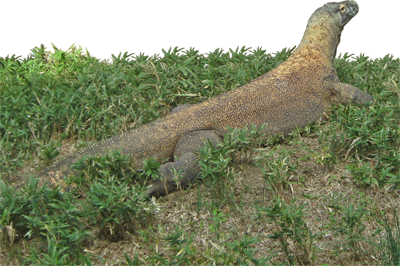 Just as some minerals respond to ultraviolet energy, this has its place in the natural order of living things too. Natural sunlight in reasonable amounts helps people to maintain good health. The importance of proper illumination for the overall health of pets and zoo animals too is becoming better appreciated, an important component of that balance is ultraviolet.
Just as some minerals respond to ultraviolet energy, this has its place in the natural order of living things too. Natural sunlight in reasonable amounts helps people to maintain good health. The importance of proper illumination for the overall health of pets and zoo animals too is becoming better appreciated, an important component of that balance is ultraviolet.
In their natural environments some animals have evolved to thrive under exposure to the most intense sunlight. Many species of reptile depend on sunlight not only to warm themselves (they are ’solar powered’ after all) but also for developing vitamin D3 and to maintain optimal health of their immune systems. It is the midwave UV-B that act on natural components of the skin of many reptiles to make vitamin D3. In the wild reptiles have adapted their behaviors to bask in the Sun, but when held captive as pets or on display reptiles do not obtain sufficient ultraviolet exposure from normal visible room light. So a properly engineered enclosure will incorporate one or more timer-controlled UV-B lamps, usually based on a Mercury Vapor bulb, installed overhead of a pet’s basking area and focused to provide suitable but not excessive exposure. Since UV-B does not penetrate glass and most other transparent material used to fabricate the enclosures, the public can observe an animal in the enclosure but not suffer ill effects (sunburn, etc) from being in the proximity of the shielded ultraviolet lamp(s).
If you intend to use any lamp for your pet then you should research the subject so that you can plan on which lamp will be suitable for your enclosure. Then prior to introducing the reptile you should monitor ultraviolet levels with a Radiometer to insure the exposure levels are safe while also being beneficial. You should also measure levels in the proximity of the enclosure to insure the materials shield observers.
In Security Applications
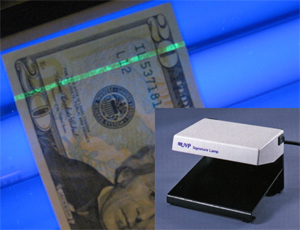 When used in security applications then an ultraviolet lamp may be used to detect security features or fraud. The ultraviolet may cause built in devices or logos to appear that might otherwise be invisible to the naked eye. Or chemicals or bleach used to alter documents may fluoresce giving away the perpetrator of the fraud.
When used in security applications then an ultraviolet lamp may be used to detect security features or fraud. The ultraviolet may cause built in devices or logos to appear that might otherwise be invisible to the naked eye. Or chemicals or bleach used to alter documents may fluoresce giving away the perpetrator of the fraud.
Right: The UVP Model SL-2M Signature Lamp (inset) facilitates the detection of fluorescence in currency, credit cards, identification badges.
Show here is the illuminating of the fluorescent security strip of a US $20 note (32,208 bytes).
The US Treasury Department has gradually been updating America’s paper currency with higher technology features to defeat counterfeiting. Some of these devices are incorporated in paper fibers that are not obvious to the naked eye under ordinary light but that fluoresce under black light (long wave) sources. When the currency is examined under longwave fluorescent light then a security ribbon embedded to the left of the portrait of President Benjamin Franklin on the $100 bill fluoresces red, the thread to the right of President Ulysses Grant on the $50 note fluoresces yellow/orange, while the thread on the left side of the portrait of President Andrew Jackson on the $20 bill fluoresces green, the thread of the $10 bill with President Alexander Hamilton is red, and that of the $5 bill with President Abraham Lincoln is blue. Even though the fluorescence intensity of the security threads appears to decrease with use and handling, the security ribbon emission bands are wide and clearly distinguish each bill.
The security thread is the only component of authentic U.S. currency that will fluoresces under black light. If the ink, the paper, or other feature fluoresces, then the bill is a counterfeit or has been altered.
Sources, Techniques, and Filters:
Sources Light sources that produce UV in quantities to be useful for imaging include: flash, incandescent, fluorescent, grid, or LED’s where there are now DUV-LED’s made for work down to about 240nm. The best choice of source will depend on the intended application (UV-A, UV-B, UV-C), the working distance from the lamp to the subject, UV source longevity. Other practical considerations include whether or not the subject could be altered or damaged by energy radiating from some sources. Company Seven offers a good selection of lamps and other equipment for work in the UV by UVP, formerly known as Ultra Violet Products Co..
It is not a simple matter to adapt conventional light sources for use in the UV since commercial lights usually do not emit sufficient UV to provide good results through a UV transmission filter.
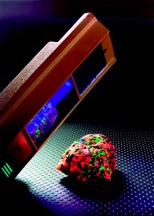 UVP UV-C lamp shown lighting a mineral sample. |
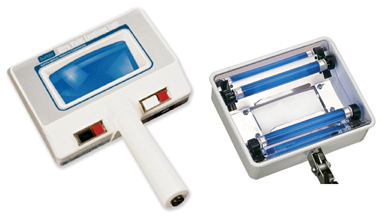 Woods Lamp 365nm UV fluorescent ’Black Light’, above and below. Typically used for magnified medical exams. |
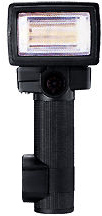 Nikon SB-140 Flash filter not shown |
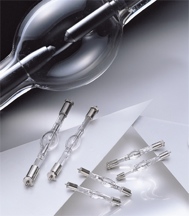 Hammamatsu Xenon or Deuterium lamp bulbs |
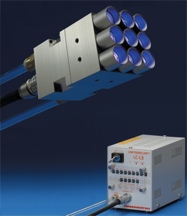 Hammamatsu UV LED with Controller |
Above: examples of common commercial UV sources (20,556, 39,782, 8,118, 10,722 then 58,009 bytes).
Click on images of UVP, Woods Lamp, and Hammamatsu items to see enlarged views (96,926, 103,757, 278,768 and 189,873 bytes).
There are light systems made specifically for UV that incorporate excitation filtering; you will find information about suppliers for minerals studies, etc. on the Internet. A shade or reflector should be used to better direct the light onto a target and eliminate stray UV light.
To freeze the moment on moving objects (flowers on a wind swept area, insects, etc.) and to minimize exposure time of the target to UV sources we prefer a flash unit; these are particularly useful when taking images in the UV-A longwave with some flash units with a suitable UV filter being able to provide UV-B midwave down to about 300nm or less. A flash unit such as the discontinued and hard to find Nikon SB-140 with provided UV pass filter may provide a peak of only approximately fifty percent or less output in the UV compared to its routine daylight performance, and this output will depend on where in the curve from below 300nm about 400nm the target best responds. There are advantages of non-flash unit too though, not the least of which is the capability of some lamps to emit well into the UV-C shortwave. It is easier to gauge the areas of the target covered by the lamp lighting, and to determine what areas if any are left in shadows (seeing the visible fluorescence). Finally, more powerful or many combined additional UV lamps can be brought to bear on the subject to reduce exposure time or to permit higher f/ratios and greater depth of field all for a fraction of the cost of even one used Nikon SB-140 flash.
The lighting sources for field photography or forensics applications should be portable and able to run off of batteries, or the lighting may be AC powered.
Of course safety gear (goggles, etc.) will also be associated with the use of most light sources. So you may want to organized a UV Kit and keep it cased and ready to go.
Techniques in order to obtain the best results when working in the UV one should first understand:
-
Induced Light Emission: when materials are exposed to ultraviolet radiation then that target may luminesce, emitting radiation at longer wavelengths. Some of this can be seen with the naked eye (visible spectrum) or may extend into the infrared. There are two types of luminescence:
Induced Light: this techniques is commonly used for studies of visible or IR fluorescence or phosphorescence and relies on two filters: excitation and blocking filters*. This requires the target be illuminated by a light source that incorporates an excitation filter so that it emits UV light but no infrared or visible. For example this may be a Kodak Wratten 18A filter that appears black and opaque to the naked eye. The camera (or sensor) that is focused onto the object of the study will incorporate a lens that has the capability to pass UV light. The lens will have a filter (Kodak Wratten 2A for example) that blocks UV light but will pass visible fluorescence. So when the target is excited by the light source then the visible or IR fluorescence or phosphorescence will be seen, and the image can be recorded by film or modern digital cameras.
-
* The same filter might be used as either an exciter or as a blocking depending on its placement within the system. For example the Kodak Wratten 18A when attached over a flash becomes an excitation filter, or when over the camera lens then functions as a blocking filter.
When working in the UV then the best results will be obtained when working in a dark room, an environment where any source of light in the visible or IR can be shielded or turned off just prior to taking the exposure.
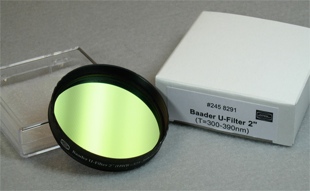 Filters Filters are used to block portions of the spectrum that we do not wish to use, so keep in mind that filters take away but can not add anything.
Filters Filters are used to block portions of the spectrum that we do not wish to use, so keep in mind that filters take away but can not add anything.
The UV Transmission Filter that was formerly made by Nikon and provided with the original UV-Nikkor lens (below) is satisfactory for most applications however, this filter has been discontinued. However, over the recent years newer technology filters have been devised that not only block visible light but also block infrared leakage. Among the newer filters recommended by and sold by Company Seven are:
The Baader U-Filter are visually opaque filters, these reject visible light and most infrared too. As typically employed the UV Transmitting Filter is installed into a filter holder (or cell), then this assembly is attached to the front hinged flap of a camera lens or in-line with our microscopes. To focus visually one slides the filter out of the way, then once focus is achieved the filter element is moved over the lens to block the visible and most IR light. For infrared photography a suitable optional filter (R60 for example) would be used in place of the UV transmitting filter. Of course if one is imaging in real time with a CCD system that displays an image on a screen then one could focus by that aid.
Film, or CCD, or ? Cameras:
Our Nikon 105mm UV lens is suitable for imaging with film or with suitable CCD detectors, or it may be incorporated into a specialized instrument (Radiometer, etc.). Most film cameras, when used with appropriate films, could do well when working into the UV or picking up visible fluorescence. There are specialized films for working deeper into the UV, most notably Eastman Kodak 103-0, but many people have obtained results with artistic and or scientific value using certain black and white films. Unfortunately, the availability and variety of films is fast diminishing as the photographic industry transitions from film to digital cameras. Of course the digital cameras provide the user with ’instant gratification’; the capability to see their results immediately and not have to pay for and wait for developing. Most consumer digital cameras have limited usefulness for work into the more interesting areas of the UV spectrum however, there are some specialized industrial UV capable cameras that can accept the Nikon F mount lenses.
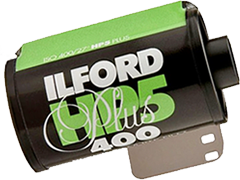 Ilford HP5 Plus Film black & white print emulsion. |
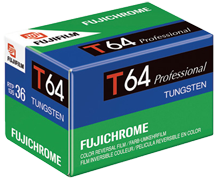 Fujifilm RPT 135 Film tungsten color slide emulsion. |
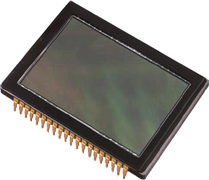 Kodak KAI series Charge Coupled Device (CCD) |
Click on images to see enlarged views (218,292, 260,322 and 300,006 bytes).
The earlier generations of DSLR cameras (including the Nikon D1, D2, D70, D200) employ a charge coupled device (CCD). Depending on the camera model a CCD based DSLR may have enough sensitivity around and below 400nm to be useful in areas beyond fluorescence in the visual spectrum. Just as the CCD based systems grew in pixels to cross the ten megapixel threshold thereby becoming truly attractive for the masses, the DSLR makers transitioned to the complementary metal-oxide-semiconductor (CMOS). The recently developed CMOS requires less power than the CCD hence longer battery life. Unfortunately, the CCD cameras are more sensitive to UV than most current CMOS as these arrays have been engineered to reduce their sensitivity to violet. The changes of sensitivity for the CMOS came about in part so that the detector will be less sensitive to false color (chromatism) that may originate from simpler lenses that will tend to show violet halos surrounding contrasting features; why make the lenses better (and more costly) when the detector can be made to not see some of the problems? While some CCD based cameras have been shown to capture UV down to below 365nm, most drop off approaching 400nm or just below that. The CMOS based Nikon D700 for example incorporates UV cut filters so that light at about 420nm and below is not registered by the CMOS.
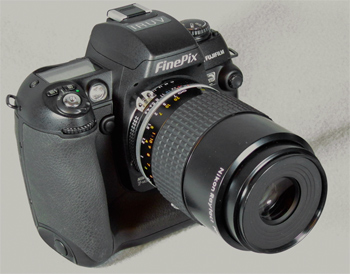 The only company that marketed production DSLR’s engineered specifically for work in the UV and IR was Fujifilm who in August 2006 introduced the FinePix S3 Pro UVIR, a DSLR based upon the conventional FinePix S3 Pro digital SLR camera but with modifications of hardware and firmware geared especially for law enforcement and scientific applications. This is a Fujifilm 12.34 megapixel SR II CCD based DSLR, an array in the DX format (23.0 x 15.5 mm). This is the world’s first production DSLR camera capable of taking photographs depending on the lens and filter attached, in the ultraviolet, or visible, or infrared light portions of the spectrum spanning from 350nm to 1 micron. Other than the ’UVIR’ label on top of the camera viewfinder, at first glance the S3 UVIR camera appears identical to its conventional S3 cousin.
The only company that marketed production DSLR’s engineered specifically for work in the UV and IR was Fujifilm who in August 2006 introduced the FinePix S3 Pro UVIR, a DSLR based upon the conventional FinePix S3 Pro digital SLR camera but with modifications of hardware and firmware geared especially for law enforcement and scientific applications. This is a Fujifilm 12.34 megapixel SR II CCD based DSLR, an array in the DX format (23.0 x 15.5 mm). This is the world’s first production DSLR camera capable of taking photographs depending on the lens and filter attached, in the ultraviolet, or visible, or infrared light portions of the spectrum spanning from 350nm to 1 micron. Other than the ’UVIR’ label on top of the camera viewfinder, at first glance the S3 UVIR camera appears identical to its conventional S3 cousin.
Left: The Fujifilm FinePix S3 UVIR the first production digital DSLR made specifically for UV/IR applications.
Shown at Company Seven with our optional Nikon UV-105 F4.5 lens (52,602 bytes).
Click on image to see enlarged view (255,046 bytes).
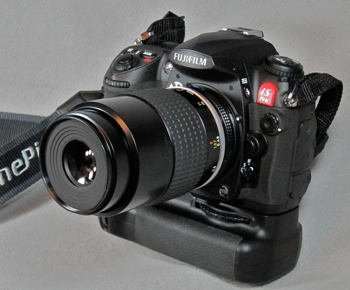 The FinePix S3 Pro UVIR was replaced in July 2007 by the Fujifilm IS Pro, a DSLR camera based upon the Fujifilm S5 Pro but incorporating factory implemented aspects making these well suited for law enforcement and scientific applications. The Fujifilm IS Pro incorporates a factory specified 12.34 megapixel Super CCD SR Pro array in the DX format (23.0 x 15.5 mm). The camera incorporates hardware and firmware features engineered specifically to facilitate working in the IR and UV from 380nm up to 1 micron; the IS Pro is somewhat less sensitive in the UV than the S3 Pro UVIR.
The FinePix S3 Pro UVIR was replaced in July 2007 by the Fujifilm IS Pro, a DSLR camera based upon the Fujifilm S5 Pro but incorporating factory implemented aspects making these well suited for law enforcement and scientific applications. The Fujifilm IS Pro incorporates a factory specified 12.34 megapixel Super CCD SR Pro array in the DX format (23.0 x 15.5 mm). The camera incorporates hardware and firmware features engineered specifically to facilitate working in the IR and UV from 380nm up to 1 micron; the IS Pro is somewhat less sensitive in the UV than the S3 Pro UVIR.
Right: The Fujifilm IS Pro may be the last and the best digital DSLR made to date specifically for UV/IR applications.
Shown at Company Seven with our optional Nikon UV-105 F4.5 lens and battery pack (46,598 bytes).
Click on image to see enlarged view (301,963 bytes).
Among the other outstanding features of these UVIR cameras are the Live Image Preview providing up to a 30-second LCD preview of the subject (in UV, visible, or IR) direct from the sensor displayed on the camera LCD monitor. The Fuji IS Pro also adds support for use with Nikon iTTL flash units. Options include special software to aid workflow, RAW file conversion, file security, and more. Furthermore, these Fujifilm DSLR’s are as compatible with most Nikon F mount autofocus or manual lenses as are modern Nikon DSLR’s so they can be used for conventional photographic work too.
Only select distributors were allowed to offer the Fujifilm UV/IR cameras. Furthermore, these cameras were sold only to selected customers who had 1. applied with a completed Fujifilm UVIR Camera Purchase Request Questionnaire, then 2. signed Fujifilm’s Ultraviolet (UV) and/or Infrared (IR) sensitive digital camera firmware End User License Agreement guaranteeing the user will use the camera only for ethical purposes for applications including forensics, science, etc. The S3 Pro UVIR and IS Pro have since been discontinued.
While today there are some companies that offer to modify some CCD based consumer DSLR’s in ways that enhance their IR capabilities, there is no practical way to enhance a CMOS based camera for work into the UV. Company Seven considers the Fujifilm UVIR cameras to be professionally consistent and otherwise notably superior to aftermarket DSLR conversions furthermore, the Fujifilm cameras were accompanied by a factory warranty and good after sale support.
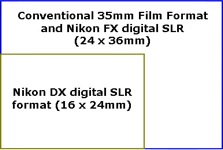 The best of the CCD based DSLR cameras incorporate a sensor with a smaller dimensional area than that of a conventional 35mm format (24 x 36mm) film camera. While these smaller sensors do preserve the approximate 3:2 aspect ratio of 35mm film, the smaller formats crop the larger image circle of conventional 35mm SLR lenses reducing the actual field of view to about forty two percent (42 %) or less, depending on the format, of the area that lens will show on a conventional 35mm SLR camera. So for example, the Nikon UV 105mm f4/5 when used on the APS-C format (Nikon DX, Fuji FinePix, etc.) format DSLR cameras appears to have a focal length of 162mm or about 1.55 times greater than that of the conventional full frame DSLR. None of the newer full frame DSLR’s incorporate a sensor that is suitable for work into the UV.
The best of the CCD based DSLR cameras incorporate a sensor with a smaller dimensional area than that of a conventional 35mm format (24 x 36mm) film camera. While these smaller sensors do preserve the approximate 3:2 aspect ratio of 35mm film, the smaller formats crop the larger image circle of conventional 35mm SLR lenses reducing the actual field of view to about forty two percent (42 %) or less, depending on the format, of the area that lens will show on a conventional 35mm SLR camera. So for example, the Nikon UV 105mm f4/5 when used on the APS-C format (Nikon DX, Fuji FinePix, etc.) format DSLR cameras appears to have a focal length of 162mm or about 1.55 times greater than that of the conventional full frame DSLR. None of the newer full frame DSLR’s incorporate a sensor that is suitable for work into the UV.
Right: “What’s the big deal?” - the respective areas of Nikon DX (15.5 x 23.3 mm) and FX (35.8 x 23.8 mm) formats compared (13,900 bytes).
Click on image to see enlarged view (92,281 bytes).
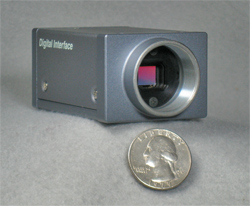 For our industrial and research clientele Company Seven does provide digital cameras and special sensing devices made specifically for work in the UV. The UV capable imaging systems tend to be special purpose devices including monochromatic cameras with comparatively small detector arrays, smaller than the FX and DX formats represented in the graphic above right. These cameras can usually be provided with a threaded lens mount or a bayonet that will accept most popular formats including the Nikon F-Mount. However, the immediate future does not look good for the hobbyist who seeks to economically explore UV digital imaging; they will be left searching out the still ample pool of new old stock or used DSLR CCD cameras or old stocks of suitable film.
For our industrial and research clientele Company Seven does provide digital cameras and special sensing devices made specifically for work in the UV. The UV capable imaging systems tend to be special purpose devices including monochromatic cameras with comparatively small detector arrays, smaller than the FX and DX formats represented in the graphic above right. These cameras can usually be provided with a threaded lens mount or a bayonet that will accept most popular formats including the Nikon F-Mount. However, the immediate future does not look good for the hobbyist who seeks to economically explore UV digital imaging; they will be left searching out the still ample pool of new old stock or used DSLR CCD cameras or old stocks of suitable film.
Left: one of our megapixel CCD cameras incorporating an uncommonly large 2/3 inch diagonal format detector, shown alongside a Quarter coin for scale (31,561 bytes).
Click on image to see enlarged view (205,738 bytes).
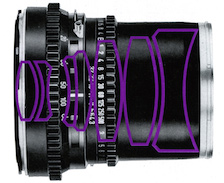 As an aside to all this in 1967 the Carl Zeiss company released the the 105mm f/4.3 UV-Sonnar, the first high performance photographic lens designed specifically to be able to take images well in the UV. The lens was manufactured for use with the medium format Hasselblad C medium format 6x 6cm film camera bodies. A later version of the UV-Sonnar lens was the CF model, made incorporating the Prontor CF shutter for use with their CF series film cameras. The UV-Sonnar consists of seven optical elements arranged in seven groups, each element is made of fluorite or fused silica (quartz) so the lens provides a flat spectral response of from 215nm to 700nm. In order to pass UV the lenses do no incorporate any antireflection coatings (as do the Nikon UV-Nikkor), hence the model and serial number lettering of all UV-Sonnar lenses is in white while conventional Hasselblad lenses of this era were made with red lettering to indicate those lenses have the Zeiss T* antireflection multicoatings.
As an aside to all this in 1967 the Carl Zeiss company released the the 105mm f/4.3 UV-Sonnar, the first high performance photographic lens designed specifically to be able to take images well in the UV. The lens was manufactured for use with the medium format Hasselblad C medium format 6x 6cm film camera bodies. A later version of the UV-Sonnar lens was the CF model, made incorporating the Prontor CF shutter for use with their CF series film cameras. The UV-Sonnar consists of seven optical elements arranged in seven groups, each element is made of fluorite or fused silica (quartz) so the lens provides a flat spectral response of from 215nm to 700nm. In order to pass UV the lenses do no incorporate any antireflection coatings (as do the Nikon UV-Nikkor), hence the model and serial number lettering of all UV-Sonnar lenses is in white while conventional Hasselblad lenses of this era were made with red lettering to indicate those lenses have the Zeiss T* antireflection multicoatings.
Right: Hasselblad UV-Sonnar C lens made by Carl Zeiss, shown with its seven element optical arrangement overlayed (29,521 bytes)
Click on image to see enlarged view (135,390 bytes).
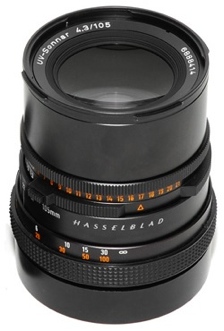 Each UV-Sonnar lens was furnished with a Zeiss UG11, a UV transmitting filter designed to block visible and some near infrared light while passing portions of the UV spectrum. The lens is housed in a filter cell with the quick to attach and release Hasselblad bayonet mount.
Each UV-Sonnar lens was furnished with a Zeiss UG11, a UV transmitting filter designed to block visible and some near infrared light while passing portions of the UV spectrum. The lens is housed in a filter cell with the quick to attach and release Hasselblad bayonet mount.
The UV-Sonnar and the later Nikon UV-Nikkor are each a remarkable lens and it is only coincidental that both are marketed as 105mm focal length lenses. The UV-Sonnar is physically a notably larger lens capturing an area 40 degrees wide across the diagonal of the traditional Hasselblad 6x 6cm (3,600 sq. mm) format, while the UV-Nikkor provides a field of view 23.2 degrees wide at prime focus on the 35mm (864.0 sq. mm) format. When new the UV-Sonnar sold for truly remarkable prices, more than double that of the UV-Nikkor, and even on the used market today a complete UV-Sonnar set in good condition can command $5,000 (USD) or more.
Left: Hasselblad UV-Sonnar CF, last production version of the lens. Note the uncoated lens surface (28,766 bytes)
In terms of practical value the UV-Sonnar remains a fine 105mm lens for use in the visual specturm. However, in terms of commanding any premium for its UV performance the UV-Sonnar might be relegated to desk ornament status since medium format films suitable for UV are nearly extinct, and Hasselblad has not made a digital camera or back that can record light into the UV. As the 35mm DSLR camera manufacturers move away from CCD to CMOS based systems that are insensitive to UV, we see the digital backs being manufactured for Hasselblad to be similar in their UV insensitivity. So with the variety of films suitable for UV work diminishing and no suitable digital cameras on the horizon, the immediate future does not look good for medium format UV imaging.
In contrast to the UV-Sonnar there remains a suitable pool of UV capable 35mm films and several DSLR CCD based cameras (Nikon, Fujifilm, etc.) that can be purchased on the used market that accept the Nikon UV-Nikkor lens.
Optics For UV Microscopy:
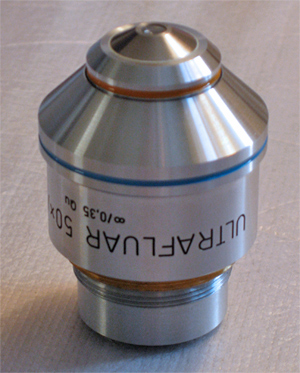 Microscopy is among the applications where ultraviolet lamps, filters and other components are employed. The Carl Zeiss company, the foremost pioneers of modern microscopes, remains in the forefront of UV lens technology too offering FLUAR, and the ULTRAFLUAR series objectives made especially to be ultra-effective for work into the ultraviolet. These are used wherever high resolution in the UV is required with Laser Scanning Microscopes for biological imaging applications, spectrophotographic work, and materials (fabrics, dyes, geological, etc.) applications. These lenses are also employed to focus UV lasers for lithography, fine etching, illumination, and other applications.
Microscopy is among the applications where ultraviolet lamps, filters and other components are employed. The Carl Zeiss company, the foremost pioneers of modern microscopes, remains in the forefront of UV lens technology too offering FLUAR, and the ULTRAFLUAR series objectives made especially to be ultra-effective for work into the ultraviolet. These are used wherever high resolution in the UV is required with Laser Scanning Microscopes for biological imaging applications, spectrophotographic work, and materials (fabrics, dyes, geological, etc.) applications. These lenses are also employed to focus UV lasers for lithography, fine etching, illumination, and other applications.
The Zeiss FLUAR series objectives are designed to detect very weak fluorescence signals. The FLUAR objectives stand for maximum light transmission and photon collection. Manufactured from special glasses, these objectives have been developed specifically for qualitative and quantitative analyses of ion modifications and for demanding fluorescence applications. These provide good flatness of field up to 23 mm, high numerical apertures and very high transmission from a wavelength of 340nm up through the visible and near infrared thus making even the weakest signals clearly visible.
Right: Very rare Carl Zeiss ULTRAFLUAR 10x, Zeiss P/N 00000-1016-786, with modern Zeiss standard M27 thread (49,814 bytes).
Both ULTRAFLUAR objective examples are from Company Seven’s collection.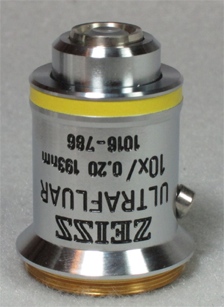 Left: Carl Zeiss ULTRAFLUAR 50x microscope objective. This model has both DIN RMS W 0,8x1/36 and M27 attachment threads (80,503 bytes).
Left: Carl Zeiss ULTRAFLUAR 50x microscope objective. This model has both DIN RMS W 0,8x1/36 and M27 attachment threads (80,503 bytes).
Mouse over image back and forth to see front and rear views.
With Zeiss ULTRAFLUAR objectives it is possible to carry out applications using fluorescence excitation even deeper into the UV wavelength range than with the FLUAR. The first of the ULTRAFLUAR objectives were designed in 1959. Only select optical grade quartz (fused silica) glasses are used in their manufacture. As with optics mentioned earlier in this article, these lenses too are not treated with any antireflective coatings, this is to avoid inhibiting UV transmission and yet their throughput remains above 70 percent from below 300nm to above 1.2 microns. These objectives demonstrate outstanding transmission from 240 nm*, through the visible, and to the infrared ranges of the spectrum. Consequently, they cover the widest spectral range and have good flatness of field up to 20 mm. Of course any coverglass over the sample on a microscope slide would need to be made of quartz so as not to inhibit UV transmission.
-
• Some ULTRAFLUAR such as that shown at right are made for work down to 193nm! This region of the spectrum, below UV-C Short Wave,
is known as the Far UV or Vacuum UV. At these extremes even oxygen in the air can attenuate UV and so the ULTRAFLUAR 193nm
objective is provided with an access port on the side for connecting a nipple (provided) and a hose for purging the oxygen out of the system
with inert gasses to improve Far UV transmission.
• Zeiss has made “Epi-ULTRAFLUAR” obectives, these are labeled as for use down to about 248nm.
• Also, do not be misled by the uniformed reseller (or crook) who may attempt to market some other microscope objective as a true ULTRAFLUAR. If the objective is not engraved at the Zeiss factory with ULTRAFLUAR then it is not an ULTRAFLUAR. There never has been any “semi-ULTRAFLUAR”, or any other “Wannabe-ULTRAFLUAR” objective produced by Zeiss.
When studying samples in a microscope in the UV these lenses are specified to be used with microscope slide cover slips that made from fused silica 200 microns in thickness hence these bear the inscription “Qu”. While some are optimized for use with immersion glycerine, those made for use with glycerine will bear the inscription “Glyc”. Some of these objectives, including the ULTRAFLUAR 100X/0.9 o.D. bear the “o.D.” as an abbreviation for the German “ohne Deckglas” indicating this lens is optimized for use on a sample without cover glass.
With these objectives you will always obtain a reliable result, even in applications with excitation light in the UV range. Of course paying for one of these super-specialized objectives is comparable to making a College tuition payment!
Please contact Company Seven for advice that may be more specific to your requirements.
For additional information specifically pertaining to the operation of ultraviolet equipment, radiometers to measure UV, filter and lamp spectral transmission data, and applications techniques browse our UVP Notes & Interesting Articles page.
-
UV General Imaging Resources: there are numerous publications and Internet sites that show what can be achieved with UV photographic techniques, many of these sites show images taken with the UV-Nikkor/UV-105 lenses. Among some of the more beautiful selections of images are those at:
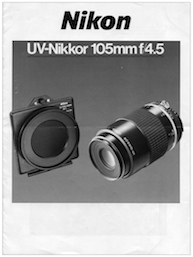 Nikon UV-Nikkor 105mm Lens illustrated eight page .pdf brochure (1,956,654 bytes) |
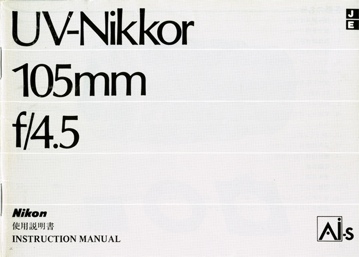
Instruction manual for original production UV-Nikkor of the 1980's. .pdf copy of an original in Company Seven’s Archives (1.66 Mb). |
 Nikon UV-105 F4.5 Lens specifications, illustrated one page .pdf brochure (243,425 bytes). |
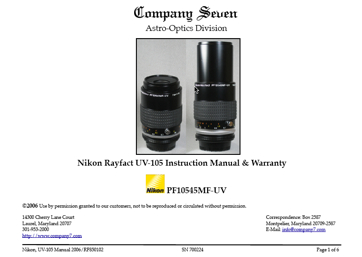
Instruction manual for 2006 production Nikon UV-105 F4.5 Lens downloadable for customers of Company Seven only by request. |
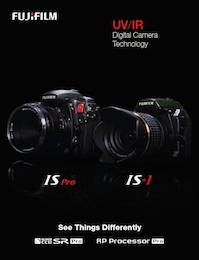 FUJIFILM UV/IR Digital Camera Technology twelve (12) page beautifully color illustrated brochure describing the Fujifilm IS Pro, the last factory produced DSLR camera (to date) specifically made for work in the UV (down to 380nm), and for visible and IR photography. Also covered is the IS-I, another Fuji camera made for IR work. Contents copyright Fujifilm, provided by Company Seven as an Adobe pdf file (4,055,405 bytes). |
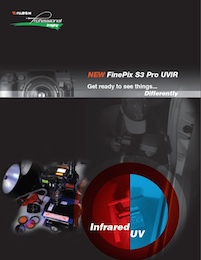 FUJIFILM FinePix S3 Pro UVIR four (4) page color illustrated brochure describing the Fujifilm S3 Pro UVIR, a special production camera. This is the first factory produced DSLR camera made specifically for work down to 350 in the UV, as well as for visible and IR photography. Contents copyright Fujifilm, provided by Company Seven as an Adobe pdf file (1,271,341 bytes). |
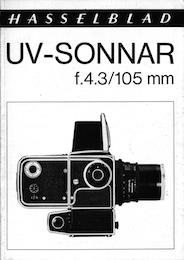 Hasselblad UV-Sonnar f4.3/105 mm complete ten (10) page illustrated booklet describing the lens formerly made by Carl Zeiss. Is an insightful overview of applications for this specialized lens focused on ultraviolet photography. Techniques shown apply to forensics, law enforcement, artworks studies, medical, and other applications. Content scanned from original in our archives in moderate 200 dpi resolution and provided by Company Seven as an Adobe pdf file (27,163,363 bytes). |
Contents Copyright 1994-2017 Company Seven, All Rights Reserved

